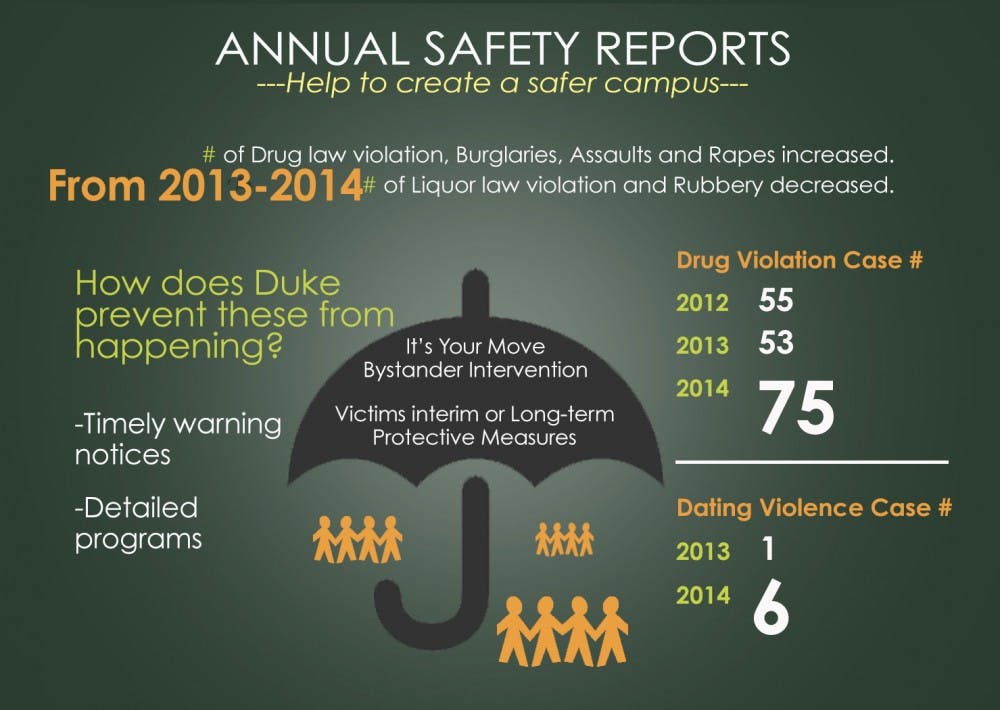Duke’s Annual Security Report showed an increased number of drug law violations in 2014.
The report contains statistics for crime committed on campus as well as certain off-campus buildings and property between 2012 and 2014. It shows that the number of drug law violation referrals, liquor law violation referrals reported and burglaries to the University increased in 2014 from the previous year, while the number of robbery reports decreased. Duke is required to release a yearly security report by the Clery Act—a federal law which attempts to increase safety and mandates that universities which receive government funding share information about crime on campus. This year’s report comes after a Duke Hospital employee was assaulted Sunday and a student was robbed on Central Campus Sept. 2.
“It’s very difficult to predict any changes that you might see year over year,” said Vice President of Administration Kyle Cavanaugh. “Most of those quite frankly have to do with situations [such as smelling] the odor of marijuana for example, where they have been referred and again handled through the student judicial process.”
Last week’s report indicated a substantial rise in the number of drug law violations referred for disciplinary action—75 in 2014, up from 53 and 55 in 2013 and 2012, respectively. In contrast, the number of robbery reports decreased from nine to two from 2013 to 2014. Statistics for multiple offenses—including burglary, aggravated assault and rape—indicated an increased number of reports in 2014, despite decreases from 2012 to 2013. There were 346 liquor law violation referrals in 2014, compared to 290 in 2013 and 542 in 2012.
This is also the second year for which the federal government has mandated that universities share data on incidents of stalking, domestic violence and dating violence. Reports of stalking on campus decreased from four in 2013 to three last year. The number of reported domestic violence incidents increased from four to six, with three reports coming from non-campus areas. Dating violence statistics indicated a jump from one reported case in 2013 to six reported cases in 2014.
Crime statistics are compiled by the Duke University Police Department and contain data for a range of offenses listed in the Clery Act. These offenses are defined by their descriptions in the Federal Uniform Crime Reporting Handbook. For weapons, drug and liquor law violations, statistics about administrative referrals are also included in the report’s spreadsheets.
“Having things such as what you’re doing on the prevention of inappropriate use of alcohol or inappropriate use of drugs are areas that are required to be articulated in the annual security report,” Cavanaugh said.
Chief of Police John Dailey and Peter Jeffries, DUPD Clery compliance and records manager, could not be reached for comment.
Most of the crimes included in the report occurred within the geographic area of the Duke campus, public property within or immediately adjacent to campus and non-campus buildings and property officially recognized or owned by the University—such as sidewalks, streets and parking facilities. Separate crime statistics were also provided for the Duke University Marine Lab which had no reported offenses in 2014.
The report also outlines the specifics of Duke’s procedures for timely warning notices and details programs to promote awareness and prevention of sexual assault, dating violence, domestic violence and stalking. It discusses Duke’s prevention training programs, including It’s Your Move bystander intervention training and procedures that allow victims to receive interim or long-term protective measures.
Administrators hope that the statistics and resources in the Annual Security Report will help to create a safer Duke community.
“We’re always monitoring [crime statistics] and other areas to insure that we’re trying to provide as safe an environment for students and the rest of the Duke community,” Cavanaugh said.
Get The Chronicle straight to your inbox
Signup for our weekly newsletter. Cancel at any time.

